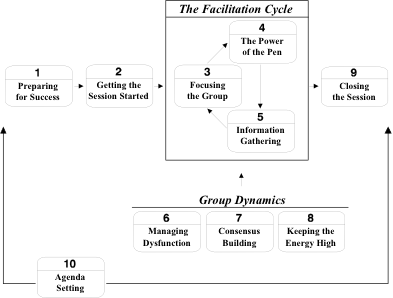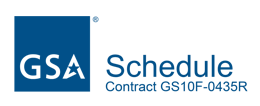Facilitation Excellence: The Seven Separators
What separates top facilitators from average ones?
Michael Wilkinson, Leadership Strategies, Inc.
In times past, it was often said that good trainers do not necessarily make good facilitators, and vice versa, good facilitators do not necessarily make good trainers. One of the primary reasons cited for this truism: training delivery focused on the ability to deliver information clearly and in an interesting way; group facilitation, however, focused on questioning skills, promoting positive interaction, and maintaining group focus. As well, the trainer needed to be a subject matter expert; however, subject expertise on the facilitator part was considered a liability to neutrality.
Yet over the last 15 years, the lines have blurred considerably. In today’s facilitated sessions, facilitators are expected to come with a strong knowledge of both process and content. And in the training classroom, the blurring is even more prominent: high interaction is in, student passivity is out; questioning and discovery is a must; straight lecture is unacceptable. More and more, trainers are expected to bring to the classroom strong group facilitation skills.
|
|
As facilitation trainers and practitioners, we have trained over 8500 facilitators since releasing The Facilitator’s Methodologytm over a decade ago. While some of our class participants were beginners, most were experienced, and many were very experienced. It is through working with both veteran and beginner facilitators that we have identified what we believe are The Seven Separators – the key skills that seem to separate the top facilitators from the average ones.
It takes numerous skills to be a great facilitator. Many skills, such as “maintaining a safe environment,” and “using the appropriate tools,” are common to both top facilitators and average ones. But for facilitators who are already good at the mechanics and are seeking to increase their facilitation excellence, we recommend that they focus on these seven skill areas.
1. Top facilitators know that it is important to establish and maintain a high energy level. Whether you are working with a group in a week-long program, or facilitating a quality team that meets for two-hours once a week, your participants are looking to you to set the pace. Why set it high? We have found that high energy does three important things:
- Engages the group by getting their attention, gaining their interest, and keeping it fun
- Energizes the topic indirectly (i.e., the facilitator’s energy around the topic suggests to the participants, “This must be important because this person seems to be excited about it.”)
- Increases the perception of facilitator’s self-confidence (Continually we have found in our business that the complementary perception is also made: facilitators with low energy are perceived by participants as having low self-confidence!)
2. In every facilitated session, there are specific times when the facilitator stops speaking and is looking to the group to speak considerably. This is very characteristic of brain-storming or listing exercises. Average facilitators figure out what questions they want to ask. Great facilitators are very conscious that the way they ask “starting questions” will greatly influence the quality of the responses. So they ask starting questions that draw a vivid image. People can “see” the question and are very quickly able to respond with information that is directly on the topic.
3. Good facilitators accept the responses given by participants and summarize when necessary. Top facilitators quickly analyze responses given and have a full toolkit of follow-up question types to apply to a variety of situations. Sometimes they will ask playback questions to verify what was said; other times they may ask direct probes to challenge, redirection questions to get back on topic, leading questions to get out of a hole, etc.
4. Good facilitators do an adequate job of recording the gist of what they heard the participants say. They may change the wording here or there to clarify, and may record what the person “meant.” In some cases, they may choose not to record certain points that they deemed unimportant. In other cases, they look to the group to decide whether someone’s point is worthy of recording. Top facilitators recognize the “power of the pen” and understand how abuse of the pen disempowers individuals and can cause dysfunctional behavior. Top facilitators record the participants’ words (not necessarily all of them) instead of their own. They write what was said, regardless of their perception of value. Once written, they use their follow-up questions to get the participant to clean up the words.
5. While average facilitators know the mechanics to handle a group in a facilitated session, top facilitators carry the group through the process. While average facilitators cover the agenda items, top facilitators smoothly transition from one agenda item to the next. Top facilitators use check points every step of the way: with every new agenda item, they review what’s been done, they preview what’s going to be done, and explain how the new agenda item contributes to the objectives established in the beginning of the session. Top facilitators use examples to ensure that participants understand. Top facilitators have a model for giving directions that allows them to always give accurate, clear, and concise instructions.
6. Average facilitators understand the importance of remaining neutral and therefore allow the discussion to go where it will as long as it stays on topic and the ground rules aren’t broken. Top facilitators separate neutrality from passivity. They are willing to challenge assumptions and seemingly questionable points to avoid the dangers of “group think.” They may float alternative ideas in order to get the group to consider a different course of action. They are careful however to speak of the benefits of all sides in order to avoid the perception of bias.
7. Every facilitation situation is unique. Yet top facilitators design customized processes to address a sponsor’s need. Top facilitators have a core set of standard agenda processes from which to draw and they know the cues for determining which agenda is appropriate in a given situation. They also have a method for building a new agenda process from scratch when needed.
The seven skills highlighted above are based on the experience of our organization. Your experience may be different and we welcome your comments. Fifteen years ago, many thought that a flip chart and a pen was all you needed to be a good facilitator. Today, we know it takes considerably more.
Michael Wilkinson is Managing Director of Leadership Strategies, a company that specializes in meeting facilitation and facilitation training. He is the author of The Secrets of Facilitation and the Secrets to Masterful Meetings and primary author of the firm’s course, The Effective Facilitator, a four-day class taught monthly in Atlanta and quarterly in cities around the nation. Mr. Wilkinson was named Facilitator of the Year for 2003 by the Southeast Association of Facilitators. To contact Mr. Wilkinson or to sign-up for his company’s bi-monthly newsletter on facilitation tips, see their website at www.leadstrat.com/.
In his upcoming half-day workshop, you will have the opportunity opportunity to learn and practice the techniques and receive detailed feedback from one of the top facilitators in the country. Don’t miss this opportunity!


